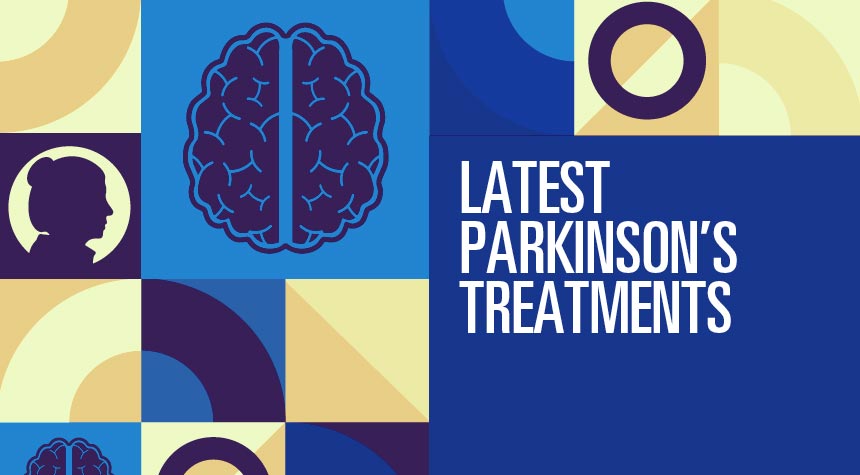
What Are the Latest Treatments for Parkinson’s Today?
Parkinson’s disease symptoms are significantly impacting the quality of life of millions of people worldwide. But innovative treatments are coming to the rescue for those who want relief from the debilitating symptoms.
Parkinson’s is a progressive movement disorder that affects an estimated one million people in the United States and more than 10 million people worldwide, according to the Parkinson’s Foundation.
Research indicates that Parkinson’s disease symptoms result from the loss of neurons in the brain that produce dopamine, a natural chemical that is essential for coordinating and controlling movement. The loss of dopamine leads to problems such as tremors, slow movement, muscle stiffness, and balance issues that increase the risk of falls.
People with Parkinson’s have “on times,” which are periods when medications keep symptoms under control, and “off times,” when symptoms worsen as the medication wears off. People with advancing Parkinson’s experience dyskinesia, which are uncontrollable movements that make it difficult to carry out daily living activities.
The new treatments for Parkinson’s aim to provide longer-lasting relief or stop the symptoms altogether by targeting specific areas in the brain affected by the disease. The following are some of the innovative treatments that have already been approved by the U.S. Food and Drug Administration (FDA):
1. MR-Guided Focused Ultrasound
Medical experts say that MR-guided Focused Ultrasound (MRgFUS) greatly benefits patients who are severely affected by tremors, rigidity, and slow movements and have not achieved adequate control with other treatments.
MRgFUS uses magnetic resonance imaging technology to provide doctors with detailed images of a specific area in the thalamus, a region of the brain involved in many body functions, including the control of movement. The ultrasound uses high-intensity sound waves to destroy the targeted tissue in that specific area without damaging the surrounding normal tissue. Destroying the targeted tissue helps to reduce or eliminate the tremors and other motor symptoms associated with Parkinson’s disease.
“Most patients will experience immediate and often dramatic improvement in their tremors immediately after the procedure,” Dr. Jeffrey S. Schweitzer, a neurosurgeon in the Department of Neurosurgery at Massachusetts Hospital, who specializes in treating tremor-dominant Parkinson’s disease, said in an interview. “The benefit is intended to be permanent and long-lasting in most people, but in some patients, there can be some return of the tremor over time.”
2. Adaptive Deep-Brain Stimulation
People with Parkinson’s disease can now receive therapy as soon as a symptom develops, thanks to a new technology known as adaptive Deep-Brain Stimulation (aDBS).
The treatment involves implanting a device in the areas of the brain affected by Parkinson’s disease. The device constantly monitors the brain for early signs that Parkinson’s symptoms are developing. Once it recognizes specific patterns of brain activity, the device sends electric pulses that can lessen symptoms. This is similar to the way a cardiac pacemaker responds to the rhythms of the heart.
Researchers say the aDBS is more personalized, efficient, and a significant advancement over the older DBS treatment, which delivered continuous stimulation to the brain.
“Until recently, these stimulation devices delivered a one-size-fits-all train of electric pulses to the brain around the clock,” Dr. Helen Bronte-Stewart, who was involved in the aDBS clinical trial, said in an interview. “They have helped some people, but are a pretty blunt tool for trying to correct the brain arrhythmias associated with Parkinson’s.”
The aDBS listens to brain activity and adjusts stimulation accordingly, Dr. Bronte-Steward, a professor of neurology and neurological sciences at Stanford University School of Medicine, explained. “It corrects brain rhythms only when needed and provides just the right degree of correction,” she said.
3. Onapgo Helps With “Off” Periods
Onapgo is a wearable infusion device that delivers apomorphine, a medication that imitates dopamine. Apomorphine reduces the frequency and severity of “off” episodes, which are times when Parkinson’s medications wear off and symptoms, such as difficulty moving and tremors, return or worsen.
“These on-again, off-again changes are disruptive and can happen at any time, which is why consistent daily control of off time is key to improving how patients feel and move,” Andrea Merriam, CEO of the Parkinson & Movement Disorder Alliance, said in a news release. “For many, continuous treatment options like Onapgo can help to make days with Parkinson’s more predictable.”
Onapgo allows apomorphine to bypass the GI tract and enter the brain, “which can allow for more predictable symptom improvement,” according to Dr. Stuart Isaacson is a clinical trial investigator for Onapgo and the Director of Parkinson’s Disease and Movement Disorders Center of Boca Raton, Florida.
The FDA’s approval of apomorphine came after the results of a clinical trial involving 107 people showed that the medication helped to manage motor fluctuations, particularly during “off” periods. After 12 weeks, Onapgo reduced daily “off” time by 2.6 hours and increased “on” time by 2.8 hours, compared to 0.9 hours and 1.1 hours with the placebo, according to the study.
Researchers say the improvements were seen as early as the first week and continued throughout the study. The most common side effects reported were bumps and redness at the infusion site, nausea, sleepiness, dizziness, headaches, anemia, and trouble falling asleep or staying asleep (insomnia). Nonetheless, the study said that participants using Onapgo reported better overall well-being.
4. Vyalev Provides Steady Flow of Medicine for Advanced Parkinson’s Patients
Medical experts are excited about Vyalev (pronounced vye-uh-lev), a liquid form of levodopa that treats motor fluctuations in adults with advanced Parkinson’s disease. Levodopa has been used for decades to treat Parkinson’s disease. Once it enters the brain, the drug is converted into dopamine to replace missing dopamine and relieve symptoms.
Levodopa is also used in combination with carbidopa, a medication that helps prevent levodopa from being broken down in the bloodstream before reaching the brain. Carbidopa/levodopa is traditionally available in oral forms, such as tablets and capsules.
Vyalev contains foscarbidopa and foslevodopa, which are converted in the body to carbidopa and levodopa. The medication is delivered through a Vyafuser, a small, wearable pump that attaches to the skin, typically on the abdomen. Since Vyalev provides a continuous flow of medication, people won’t need to take pills multiple times a day.
The pump is a “game changer,” according to Dr. Drew Kern, a movement-disorders neurologist at the University of Colorado School of Medicine, who is running three long-term extension studies on the device. Not only does it deliver a steady flow of medication, but the pump can precisely adjust dosing, a task that is difficult to achieve with pills.
Also, Vyalev offers an option for patients who aren’t interested in or for whom deep-brain stimulation neurosurgery is too high-risk due to their age or health status.
“By the time somebody’s five or 10 years into the disease course, there’s a high likelihood they would benefit from this treatment,” Dr. Kern said in an interview.
Source Links:
https://www.parkinson.org/understanding-parkinsons/statistics/prevalence-incidence
https://advances.massgeneral.org/neuro/q-a.aspx?id=1024
https://med.stanford.edu/news/all-news/2025/02/deep-adaptive-brain-stimulation-parkinsons.html
https://www.webmd.com/parkinsons-disease/news/20250206/fda-oks-new-wearable-infusion-device-for-parkinsons
https://ir.supernus.com/news-releases/news-release-details/supernus-announces-fda-approval-onapgotm-apomorphine
https://www.uchealth.org/today/vyalev-pump-eases-off-periods-for-advanced-parkinsons-patients/







